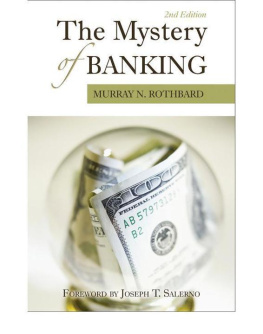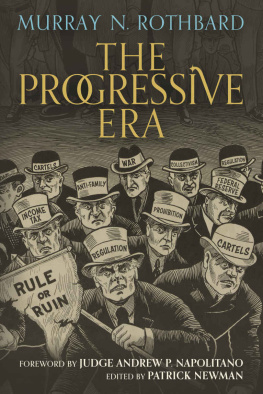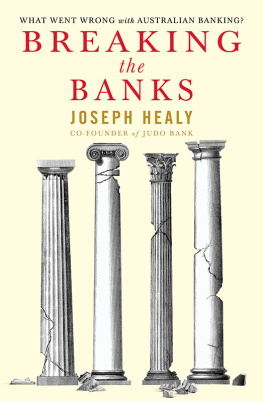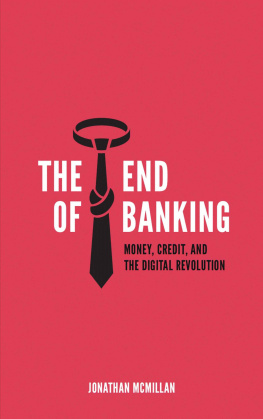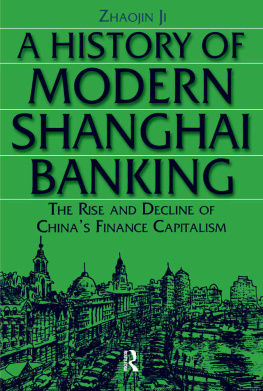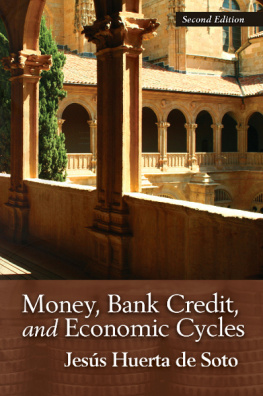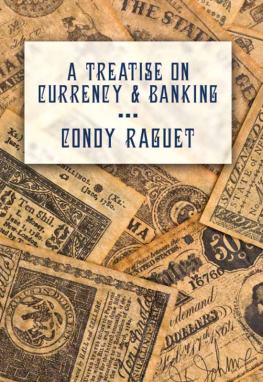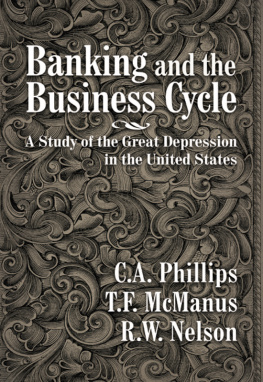The Mystery
of Banking
MURRAY N. ROTHBARD
SECOND EDITION


Copyright 2008 by the Ludwig von Mises Institute
All rights reserved. No part of this book may be reproduced in any manner whatsoever without written permission except in the case of reprints in the context of reviews.
For information write the Ludwig von Mises Institute, 518 West Magnolia Avenue, Auburn, Alabama 36832. Mises.org.
ISBN: 978-1-933550-28-2
To Thomas Jefferson,
Charles Holt Campbell,
Ludwig von Mises
Champions of Hard Money
The Ludwig von Mises Institute thanks Mr. Douglas E. French and Ms. Deanna Forbush for their magnificent sponsorship of the publication of this book.
CONTENTS
PREFACE
A lthough first published 25 years ago, Murray Rothbards The Mystery of Banking continues to be the only book that clearly and concisely explains the modern fractional reserve banking system, its origins, and its devastating effects on the lives of every man, woman, and child. It is especially appropriate in a year that will see; a surge in bank failures, central banks around the globe bailing out failed commercial and investment banks, double-digit inflation rates in many parts of the world and hyperinflation completely destroying Zimbabwes economy, that a new edition of Rothbards classic work be republished and made available through the efforts of Lew Rockwell and the staff at the Ludwig von Mises Institute at an obtainable price for students and laymen interested in the vagaries of banking and how inflation and business cycles are created.
In the absence of central-bank intervention, the current financial meltdown could be a healthy check on the inflation of the banking system as Rothbard points out in his scathing review of Lawrence H. Whites Free Banking in Britain: Theory, Experience, and Debate, 1800-1845 that first appeared in The Review of Austrian Economics and is included as a part of this new edition to correct Rothbards initial support of Whites work in the first edition. There have been virtually no bank failures in the United States since the early 1990s and as Rothbard surmised during that period where there was an absence of failure that inflation of money and credit [was] all the more rampant. Indeed, from January 1990 to April 2008, the United States M-2 money supply more than doubled from $3.2 trillion to $7.7 trillion. Bankers were living it up, at the expense of society and the economy faring worse (Rothbards emphasis).
Although ostensibly it is dodgy real estate loans that are bringing the banks down this year, in the seminal book that you hold, Rothbard shows that it is really the fraudulent nature of fractionalized banking that is the real culprit for the bankers demise.
But central bankers will never learn. We should not have a system thats this fragile, that causes this much risk to the economy, New York Federal Reserve President Tim Geithner said after engineering J.P. Morgans bailout of the failed Bear Stearns investment bank in the first quarter of 2008 with the help of the central bank. Of course the thought of dismantling his employer, the government leaving the counterfeiting business, and a return to using the markets moneygolddidnt occur to him. More government regulation in which the basic rules of the game establish stronger incentives for building more robust shock absorbers, is what he prescribed.
Surely Murray is somewhere laughing.
My introduction to The Mystery of Banking came in 1992 as I was finishing my thesis at UNLV under Murrays direction. I found the book in the university library and couldnt put it down. The book was long out of print by that time and being prior to the start of Amazon.com and other online used book searches, I was unable to find a copy of the book for purchase. Thus, I fed dimes into the library copier one Saturday afternoon and made myself a copy. When the online searches became available I waited patiently and bought two copies when they surfaced, paying many times the original $19.95 retail price (as I write this AbeBooks.com has three copies for sale ranging from $199 to $225, and Bauman Rare Books recently sold a signed first edition for $650).
When I discovered Rothbards great work I had been a banker for six years, but like most people working in banking, I had no clear understanding of the industry. It is not knowledge that is taught on the job. Murray may have referred to me as the efficient banker, but he was the one who knew the evil implications of the modern fractionalized banking system: the pernicious and inflationary domination of the State.
D OUGLAS E. F RENCH
L AS V EGAS , N EVADA
J UNE 2008
FOREWORD
L ong out of print, The Mystery of Banking is perhaps the least appreciated work among Murray Rothbards prodigious body of output. This is a shame because it is a model of how to apply sound economic theory, dispassionately and objectively, to the origins and development of real-world institutions and to assess their consequences. It is institutional economics at its best. In this book, the institution under scrutiny is central banking as historically embodied in the Federal Reserve Systemthe Fed for shortthe central bank of the United States.
The Fed has long been taken for granted in American life and, since the mid-1980s until very recently, had even come to be venerated. Economists, financial experts, corporate CEOs, Wall Street bankers, media pundits, and even the small business owners and investors on Main Street began to speak or write about the Fed in awed and reverential terms. Fed Chairmen Paul Volcker and especially his successor Alan Greenspan achieved mythic stature during this period and were the subjects of a blizzard of fawning media stories and biographies. With the bursting of the high-tech bubble in the late 1990s, the image of the Fed as the deft and all-seeing helmsman of the economy began to tarnish. But it was the completely unforeseen eruption of the wave of sub-prime mortgage defaults in the middle of this decade, followed by the Feds panicky bailout of major financial institutions and the onset of incipient stagflation, that has profoundly shaken the widespread confidence in the wisdom and competence of the Fed. Never was the time more propitious for the radical and penetrating critique of the Fed and fractional-reserve banking that Roth-bard offers in this volume.
Before taking a closer look at the books contents and contributions, a brief account of its ill-fated publication history is in order. It was originally published in 1983 by a short-lived and eclectic publishing house, Richardson & Snyder, which also published around the same time Gods Broker, the controversial book on the life of Pope John Paul II by Antoni Gronowicz. The latter book was soon withdrawn, which led to the dissolution of the company. A little later, the successor company, Richardson & Steirman, published the highly touted A Time for Peace by Mikhail Gorbachev, then premier of the U.S.S.R. This publishing coup, however, did not prevent this firm from also winding up its affairs in short order, as it seems to have disappeared after 1988.
In addition to its untimely status as an orphan book, there were a number of other factors that stunted the circulation of The Mystery of Banking. First, several reviewers of the original edition pointedly noted the lax, or nonexistent, copy editing and inferior production standards that disfigured its appearance. Second, in an important sense, the book was published before its time. In 1983, its year of publication, the efforts of the Volcker Fed to rein in the double-digit price inflation of the late 1970s had just begun to show success. Price inflation was to remain at or below 5 percent for the rest of the decade. During the 1990s, inflation, as measured by the Consumer Price Index, declined even further and hovered between 2 and 3 percent. This led the Greenspan Fed and most professional monetary economists to triumphantly declare victory over the inflation foe and even to raise the possibility of a return of the deflation bogey.
Next page
